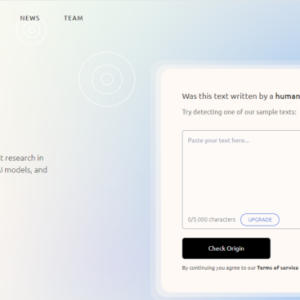In the rapidly evolving world of podcasting, artificial intelligence (AI) has emerged as a powerful tool for content creators. From enhancing audio quality to streamlining transcription and editing processes, AI tools have revolutionized the way podcasters produce and distribute their content. In this article, we will explore some of the best AI tools available to podcasters, ranging from voice recognition software to automated transcription services, and discuss how they can significantly enhance the overall podcasting experience. Whether you are a seasoned podcaster or just starting out, these AI tools can help you take your podcasting game to the next level.
We’ve entered a new era of content creation, where machine learning and artificial intelligence are no longer buzzwords, but rather powerful tools in our creative processes. One of the best use cases is in repurposing content from one medium to another, like podcasting.
You are viewing: From Podcasts to Blogs: The Best AI Tools for Podcasters
While the industry may have its roots in traditional media formats, cutting-edge AI tools for podcasters are changing the game. In this post we’ll drill down very closely on the relationship of AI with podcasts and blogposts, to make it easy to turn one into the other.
A New Approach to Content: From Podcasts to Blog Posts
Traditionally, podcasters and writers operated in somewhat separate realms. However, modern AI technology is tearing down that wall and opening doors for creators. Prior to the advent of tools like ChatGPT or Google Bard, repurposing content from one format to another was a much more labor-intensive task that took a bit of time.
Now, with a few different AI-assisted tools, you can transform a podcast into a blog post in no time, or vice versa. Video-recording platforms like YouTube and Riverside are getting increasingly intelligent to the point where recorded voices are now able to be transcribed automatically via AI.
With Riverside, for example, a podcaster doesn’t have to painstakingly listen and type out their podcast episodes. Instead, the AI provides a near-perfect transcription in no time at all:

Rev is another tool that is extremely competent at transcribing videos and podcast episodes from Spotify or other sources with fast turnarounds:

There are also a handful of free tools out there, all of which are capable of converting recorded voice into written text, like:
And it doesn’t stop there. After acquiring the transcription, the data can be fed into another AI service like ChatGPT, which can convert it into a blog post with specific formatting elements such as headers, lists, highlighted takeaways, etc:

Cost and Time Efficiency: Our Process on Adapting Podcasts to Articles
See more : 10 Best GPT3 Tools To Boost Your Productivity: Both Free and Paid
Traditional content creation requires a lot of minutiae and steps before you can actually start adapting the content to your desired format. Leveraging generative AI can help you blow past a lot of those steps, helping you get to the creative part a lot quicker.
However, we should be clear that we’re not advocating that you just plop your transcript into ChatGPT or Google Bard and publish it as-is. No way. The result would be pretty awful, as these AI tools have their limitations:

The correct answer to the above question is two times. India won the cricket world cup first in 1983 and then in 2011.
Where the human finesse comes in is crafting the right prompt from the start, followed by parsing through the response and making tweaks and edits where necessary.
We have gone through numerous iterations of prompts before arriving at a suitable template that we use to preface every ChatGPT session meant to adapt a podcast episode into a blog post.
Here’s an example of how we structure our prompt for ChatGPT and Bard to get the best possible response on the first try:
“Take the following ####-word podcast transcript featuring two hosts and convert it into a 1,500-word blog post that sounds as though it was written by a single author. The focus keyword is “______.” Ensure that the writing flows smoothly, feels cohesive, and expands upon the key points in a meaningful way. Retain the essential information and the spirit of the conversation, but you can rephrase, add context, or provide examples as needed.
Here is the transcript: [ ]”
From there, ChatGPT will produce a (usually) decent blog post from the transcript. It’s never perfect, but this is where human editing comes into the picture.
An editor will focus on enriching the content by cleaning up the language, as well as adding statistics, relevant links and images. This optimizes both costs and the quality of the output, demonstrating that AI doesn’t just replace human input but enhances it.
It’s important to note that the more effort you put into your prompt, defining your output criteria, the more likely the response from ChatGPT or whichever language model you are using will be accurate to what you need.
See more : ChatGPT for Lawyers: How Can This AI Tool Help Improve Your Effectiveness?
In a word, these language models thrive on specificity.
Streamlining Client Communications with AI
So, Riverside and ChatGPT tackle content creation, but what about client communication? The answer lies in the integration of AI with sales intelligence tools.
Our go-to solution is Gong, an AI tool that records client calls and provides actionable insights for sales team members:

Gong is an emotion detector and not just a recording tool. It serves as. By analyzing the nuances of a call, it helps businesses gauge the sentiment of the client. This evaluation is then rated on a scale from one to ten, with ten being the best.
Imagine a traffic light system for your business relationships. That’s the model Gong uses. Scores of 9 or 10 translate to a green light, indicating all is well. Yellow signifies scores between 7 and 8, a signal to proceed with caution. Any score of 6 and below is a red light, urging immediate action.
This emotion detection feature is usually integrated into a real-time dashboard, collating scores into a weekly spreadsheet. With such a system in place, a business can easily track the state of client relationships over time.
For instance, if a client’s sentiment is yellow or red for three consecutive weeks, the alarm bells should ring. This proactive approach allows businesses to identify issues before they become full-blown problems, leading to better client relationships and ultimately, better business outcomes.
Last Word on AI Tools for Podcasters
AI is doing far more than just automating repetitive tasks. It’s revolutionizing how we think about content creation and client relationships. From Riverside’s ability to transcribe spoken material passively to Gong’s sentiment analysis features, the scope for innovation is vast.
So whether you’re a podcaster, a digital marketer or a business strategist, the question isn’t whether you should adopt AI tools but when.
For more insights and lessons about marketing, check out our Marketing School podcast on YouTube.
That’s a wrap on “From Podcasts to Blogs: The Best AI Tools for Podcasters” We hope you’ve found a trove of useful insights and fresh perspectives. Your opinions and ideas matter to us—join the conversation below and share your take! Hungry for more tech insights? Dive into our diverse collection of articles where innovation meets practicality. Discover More AI Softwares.
Stay in the loop with the latest in AI and tech – your journey into the digital future continues at duanetoops.com.
#Podcasts #Blogs #Tools #Podcasters
Source: https://duanetoops.com
Category: AI





